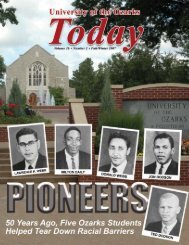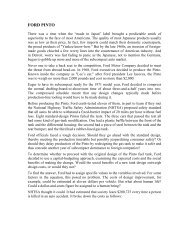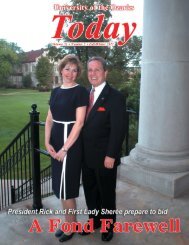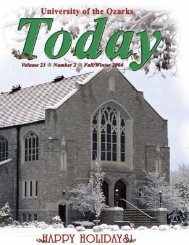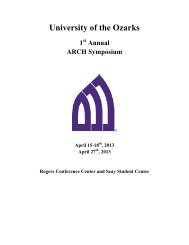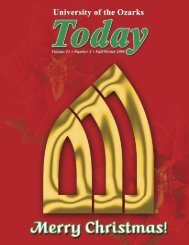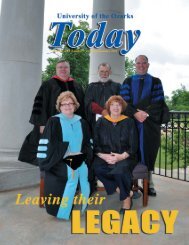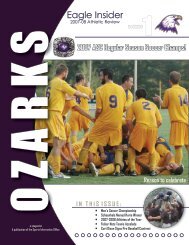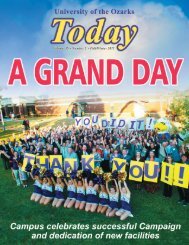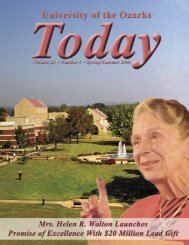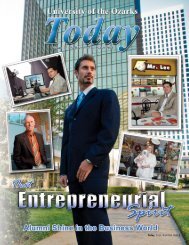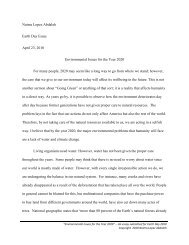Download a PDF of the Spring/Summer 2004 Issue
Download a PDF of the Spring/Summer 2004 Issue
Download a PDF of the Spring/Summer 2004 Issue
- No tags were found...
You also want an ePaper? Increase the reach of your titles
YUMPU automatically turns print PDFs into web optimized ePapers that Google loves.
tremendous impact <strong>the</strong> university’s faculty members arehaving on young lives. Ozarks’ faculty are not just following<strong>the</strong> lead in higher education, but <strong>the</strong>y are among <strong>the</strong> trendsettersin areas such as classroom innovation, assessment andproviding <strong>the</strong>ir students with real-world experience.One <strong>of</strong> <strong>the</strong> strongest indicators <strong>of</strong> <strong>the</strong> success <strong>of</strong> Ozarks’faculty is an independent, national survey called <strong>the</strong> NationalSurvey <strong>of</strong> Student Engagement (NSSE). The surveyinterviews both first-year students and seniors at 649 collegesand universities throughout <strong>the</strong> country. The survey examinesareas such as level <strong>of</strong> academic challenge, active andcollaborative learning, student-faculty interaction, enrichingeducational experience and supportive campus environment.In every category <strong>of</strong> <strong>the</strong> 2003 NSSE study, for both firstyearand senior students, Ozarks scored above both <strong>the</strong>national level and its peer group. In many areas, such assupportive campus environment and student-facultyinteraction, Ozarks scored well above its peers.“Across <strong>the</strong> country, results from NSSE are reviewed asgood indicators <strong>of</strong> quality because this survey measures ‘bestpractices’ in <strong>the</strong> education <strong>of</strong> students,” said Vice Presidentfor Academic Affairs Dr. Daniel Taddie. “The focus issquarely on what helps students learn. We’re proud <strong>of</strong> <strong>the</strong> factthat Ozarks measures up so well on this national indicator <strong>of</strong>quality because it means that we are effectively fulfilling ourmission, which states that ‘our first priority is <strong>the</strong> education<strong>of</strong> students.’ ”Dr. David Strain, chair <strong>of</strong> <strong>the</strong> Division <strong>of</strong> Humanities andFine Arts and a Harvard alumnus, said Ozarks’ small campusenvironment fosters innovative thinking among alldisciplines.“We don’t have <strong>the</strong> real structured departments here, andI think that helps faculty members get toge<strong>the</strong>r, ei<strong>the</strong>rformally or informally, and talk about teaching techniquesand what <strong>the</strong>y have found works or doesn’t work forstudents,” Strain said. “One <strong>of</strong> <strong>the</strong> greatest gifts Ozarks has,in regard to sharing ideas, is <strong>the</strong> campus mall. Thearchitectural design <strong>of</strong> <strong>the</strong> campus makes it necessary foreveryone to walk by everyone else and that promotes gettingto know o<strong>the</strong>r faculty members.At Ozarks, <strong>the</strong>re is really asense <strong>of</strong> sharing ideas andbouncing different techniquesaround that you don’t find atlarger campuses.”Dr. Sean Coleman, apr<strong>of</strong>essor <strong>of</strong> biology who cameto Ozarks in 2000 right out <strong>of</strong><strong>the</strong> Ph.D. program at <strong>the</strong>University <strong>of</strong> Iowa, said hiscolleagues helped make his transition to <strong>the</strong> university mucheasier.“The o<strong>the</strong>r faculty members, both in my division andthroughout campus, took <strong>the</strong> time to help me get acclimated toteaching at <strong>the</strong> college level,” Coleman said. “One <strong>of</strong> <strong>the</strong> firstthings I noticed about Ozarks was <strong>the</strong> collegial environmentthat is here and how much o<strong>the</strong>r faculty members are willingto help you. I’ve learned so much, not only from faculty inmy own division, but from my friends and colleagues in <strong>the</strong>Division <strong>of</strong> Humanities and Fine Arts as well as <strong>the</strong> o<strong>the</strong>rdivisions on campus.”Dr. Sharon Gorman, pr<strong>of</strong>essor <strong>of</strong> music and a Stanfordgraduate, has helped organize more formal sharing <strong>of</strong> teachingideas through monthly teaching forums. Usually <strong>the</strong>re arespecific topics and presenters, but <strong>of</strong>ten <strong>the</strong> forums are opento whatever faculty members want to discuss.“Faculty love to talk about teaching — we chat about itin each o<strong>the</strong>r’s <strong>of</strong>fices, on <strong>the</strong> way to classes, in <strong>the</strong> hallwaysand over meals,” Gorman said. “But traditionally <strong>the</strong>re hasbeen no formal setting for sharing <strong>the</strong>se ideas widely acrosscampus and that’s how <strong>the</strong> teaching forums came about.We’ve talked about learning styles, collaborative learning,supplemental instruction, how to lecture, understandinglearning disabilities, classroom behavior and a variety <strong>of</strong> o<strong>the</strong>rissues. U <strong>of</strong> O has a wonderful, collegial faculty who enjoysharing ideas and helping one ano<strong>the</strong>r with problems. It’sbeen a good experience.”Strain believes <strong>the</strong> academic environment at Ozarksencourages “outside-<strong>the</strong>-box” thinking by faculty members in<strong>the</strong>ir approach to classroom teaching. He cites, as an example,two language “immersion” classes in French and Italian thatContinued on Page 16Today, SPRING/SUMMER <strong>2004</strong> 17



